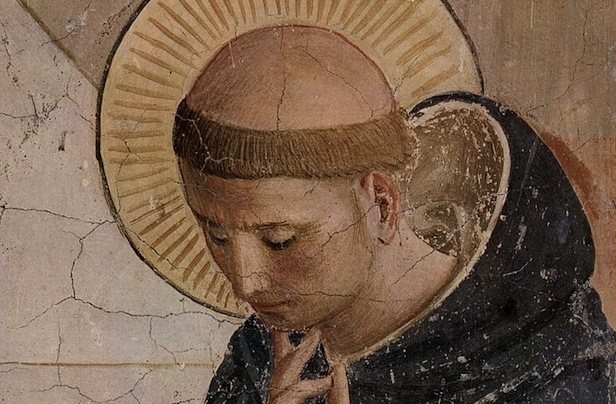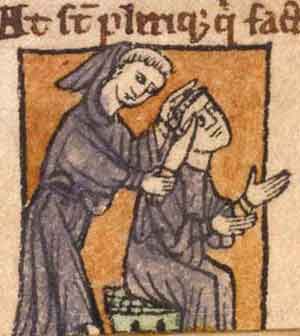Partial shaving may have its origins in ancient Egypt Greece and other places where men shaved a circular bald spot on top of their heads to honor the sun god. Current usage more generally refers to cutting or shaving for monks devotees or mystics o.
By removing the hair of a servant their masters dehumanized them.

Why did medieval monks shave their heads. Its worth clarifying that Buddhist monks shave their heads but practicing lay-people tend not to. Its thought to symbolize age when a man starts balding in the back - therefore making the monk more respected as. Tonsure can also refer to the secular practice of shaving all or part of the scalp to show support or sympathy or to designate mourning.
For example for Merovingians an unsuccessful pretender or dethroned king would be tonsured. Short hair or no hair was only saved for monks. Tonsure is the practice of cutting or shaving some or all of the hair on the scalp as a sign of religious devotion or humility.
A solution to this dilemma was a haircut that satisfied both the bible and the pope. Did women have queues. Its not just Christian monks who do it - Buddhist and Hindu monks do it as well.
To maintain their queues men had to shave the remainder of their heads approximately every ten days. In modern times tonsure refers to cutting or shaving hair by monks or religious devotees. Monks and nuns in the Middle Ages generally showed that they were monks by cutting their hair short when most people wore theirs long.
Tonsure has been around since the medieval Catholic times but was then abandoned in 1972 by the papal order. Young tonsured monks at school Tonsure means to cut off someones hair. Muslim men have the choice of shaving their head after performing the Umrah and Hajj following the tradition of committing to Allah but are not required to.
Additionally since a shaved head was often associated with slaves the newly shaved monk became a slave of Christ. Monks shaved the top of their heads to show tribute to Saint Paul and kept the edges of their hair to also respect the bible. The term originates from the Latin word tonsura and referred to a specific practice in medieval Catholicism abandoned by papal order in 1972.
Refusal to shave ones hair into a queue was treason against the emperor punishable by death. Some orders of monks who left a narrow crown of hair around their heads said that this signified the crown of thorns placed on Christs head during his crucifixion. Male monks then shaved their heads in kind to indicate their status as slaves of Christ The narrow crown of hair also evokes images of the crown of thrones placed on Christ during his crucifixion.
Before the shave a prayer called the benedictio ad barbam or blessing of the beard would be said. After the shaving the hair and whiskers were consecrated on an altar. A possible connection to slavery was established by linking the appearance to a shaved head.
There are a few reasons why early monks might have chosen to go for this sort of look and one is that it had long been traditional to completely shave the head of slaves to denote their low status. The Manchus cut short much of the discussion on queue-shaving by instituting a Lose your hair or lose your head policy. The first depictions of the Buddha in human form were made by the artists of Gandhara a Buddhist kingdom that was located in what is now Pakistan and Afghanistan 2000 years or so agoThe artists of Gandhara were influenced by Greek and Roman art as well as Persian and Indian art and many of the earliest Buddhas sculpted in the early first millennium CE was sculpted in an unmistakably.
Its observed that Early monks styled themselves as slaves of Christ. Some monks cut their hair short while others shaved it off completely or shaved part of their head. Early monks styled themselves as slaves of Christ and the tonsure might have been a way to demonstrate their obedience to the divine.
The new bizarre haircut was named the tonsure and was worn by almost every Catholic monks in Europe in medieval times. In Buddhism shaving your head and face is part of Pabbajja. Buddhist monks are not the only men of God to shave their heads it was also a Catholic and early Christian sign of devotion to their God.
Christian monks got a special short haircut by shaving a bald spot in the middle of the back of their heads. After this he had to retire to a monastery where he would remain until his hair grew back. Sometimes referred to as the monastic crown the haircut has come to symbolise religious devotion and the rejection of worldly possessions.
One superficial reason would be that its part of the monks rules of conduct although there are different sets of those since there are different main branches of Buddhism surely discussed in other questions here. This is why some kings would have the heads of their rivals shaved in order to have no competition for themselves. It was a way to immediately identify a monk if they went out into the general public as their clothing was not substantially different from much of what the peasants wore.
Pabbajja is when a person leaves their home and goes forth to live the life of a Buddhist renunciate among ordained monks. The tonsure was cut when they made their first vows and renewed thereafter assuming they made lifetime vows. Many Buddhists and Vaisnavas especially Hare Krishnas shave their headsSome Hindu and most Buddhist monks and nuns shave their heads upon entering their order and Buddhist monks and nuns in Korea have their heads shaved every 15 days.
Ridding of your hair serves as a symbol of renunciation of worldly ego and fashion. During the early centuries of monasticism there arose a discussion. A man who decided to devote himself to a monastic life would often undergo an initiatory first shave that was observed by the other monks in the monastery.
Many Catholic and Christian men would shave a spot and leave a crown of hair to show the symbol of the crown of thorns.
 Franciscan Monks High Middle Ages Early Middle Ages Middle Ages
Franciscan Monks High Middle Ages Early Middle Ages Middle Ages
 Why Do Monks Have Shaved Heads All About History
Why Do Monks Have Shaved Heads All About History
 The Hair Raising History Behind The Monks Strange Haircut
The Hair Raising History Behind The Monks Strange Haircut
 Image Result For Torches In Medieval Paintings Illuminated Manuscript Medieval Paintings St Cuthbert
Image Result For Torches In Medieval Paintings Illuminated Manuscript Medieval Paintings St Cuthbert
 Eadfrith Monks On St Cuthbert S Hermitage On The Farne Illuminated Manuscript Medieval Paintings St Cuthbert
Eadfrith Monks On St Cuthbert S Hermitage On The Farne Illuminated Manuscript Medieval Paintings St Cuthbert
 The Daily Life Of Medieval Monks World History Encyclopedia
The Daily Life Of Medieval Monks World History Encyclopedia
Monks Monasteries The Dark Knights
 Plucked Shaved Braided Grooming In The Middle Ages
Plucked Shaved Braided Grooming In The Middle Ages
 Xuanzang Buddhist Artwork Buddhism Buddhist
Xuanzang Buddhist Artwork Buddhism Buddhist
 Pin By Mike Sturgeon On Medieval Art Kingdom Come Deliverance Catholic Art Medieval Art
Pin By Mike Sturgeon On Medieval Art Kingdom Come Deliverance Catholic Art Medieval Art
Why Do Buddhist Monks Shave Their Heads
 Why Do Monks Have Strange Haircuts
Why Do Monks Have Strange Haircuts
 What Is Tonsure Medieval Christianity Quatr Us Study Guides
What Is Tonsure Medieval Christianity Quatr Us Study Guides
 A Quick Guide To Medieval Monastic Orders Medieval Monastic Benedictine Monks
A Quick Guide To Medieval Monastic Orders Medieval Monastic Benedictine Monks
 Imgur Com Dnd D D Hat Hairstyles
Imgur Com Dnd D D Hat Hairstyles



